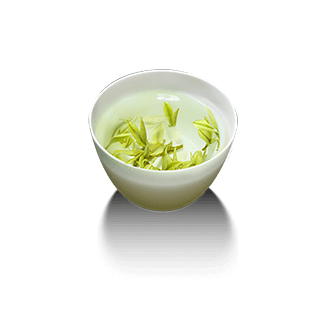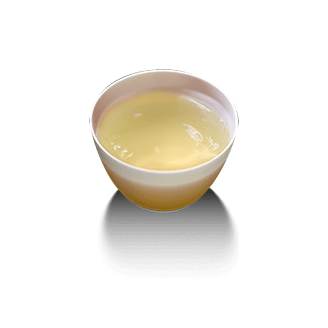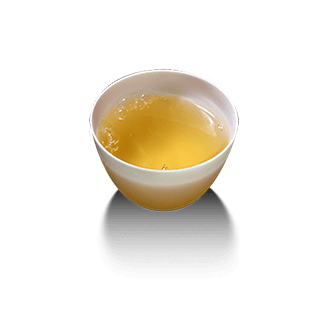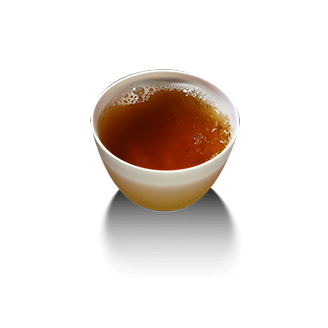

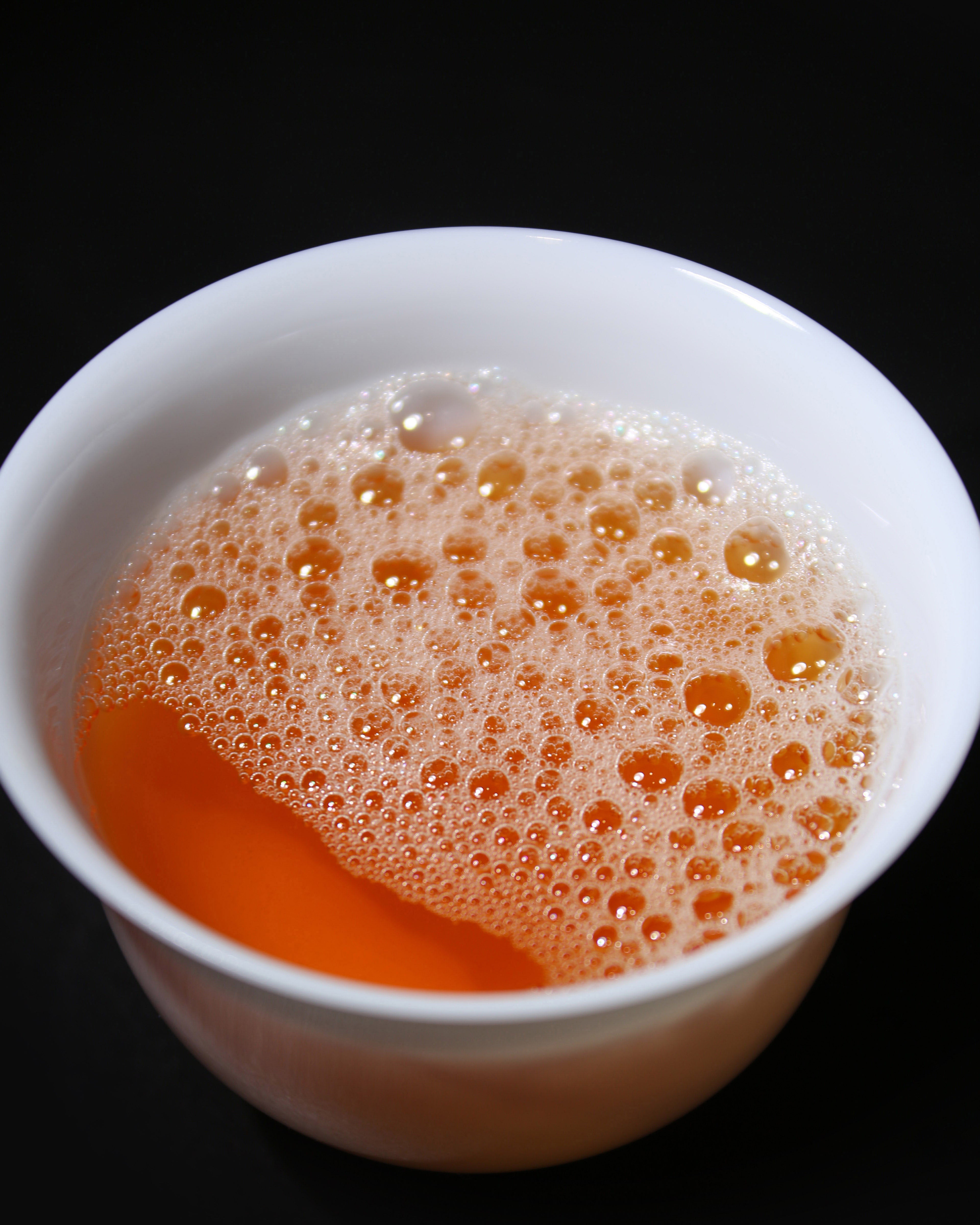
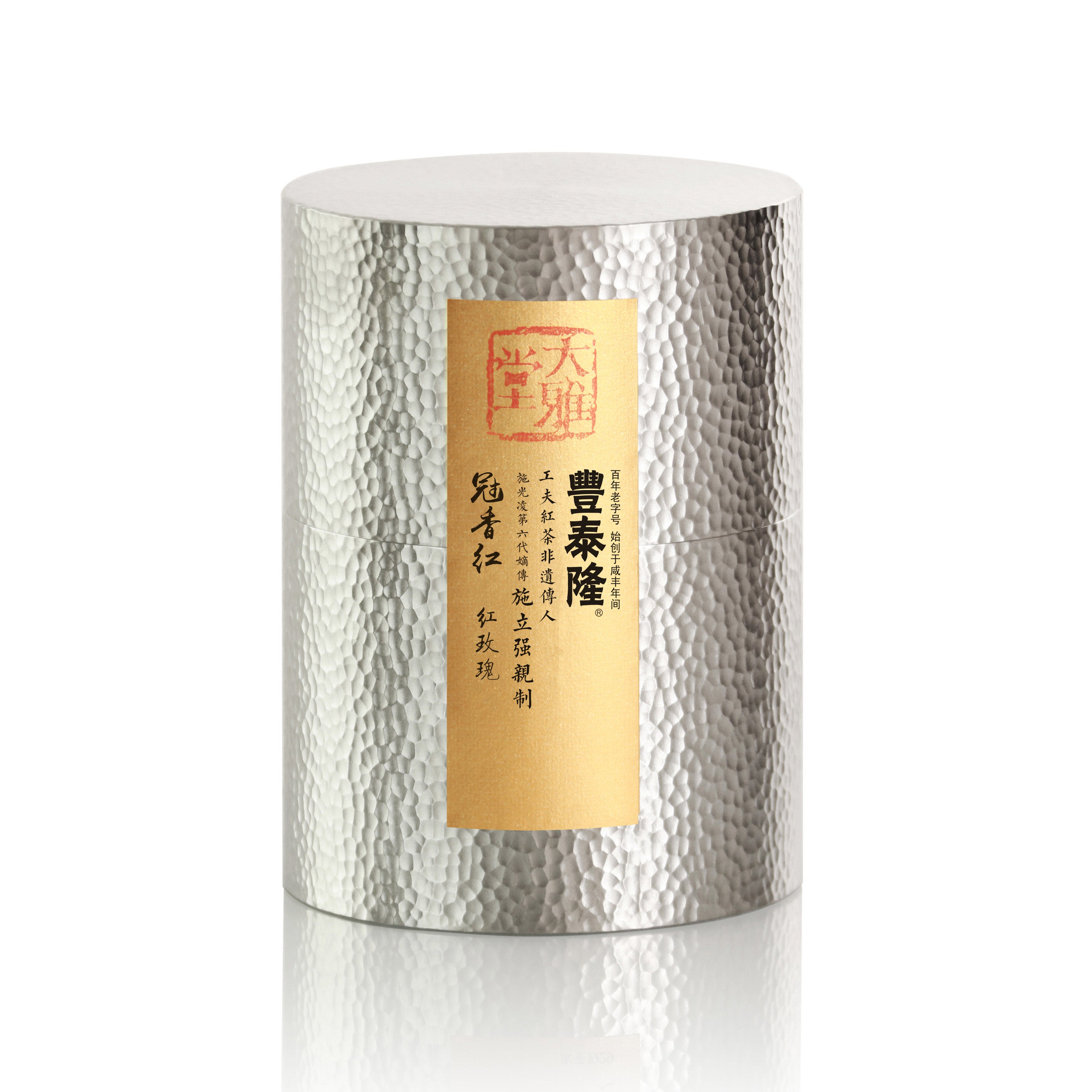

Age-Defying AromaPrimeTea Crown Fragrance Red
获“中华人民共和国农业部植物新品种权”证书






Age-Defying AromaPrimeTea Crown Fragrance Red
获“中华人民共和国农业部植物新品种权”证书
Age-Defying AromaPrimeTea Crown Fragrance Red
获“中华人民共和国农业部植物新品种权”证书
Shi Liqiang, the inheritor of the intangible cultural heritage of Gongfu black tea and the founder of this tea variety, personally crafted it.
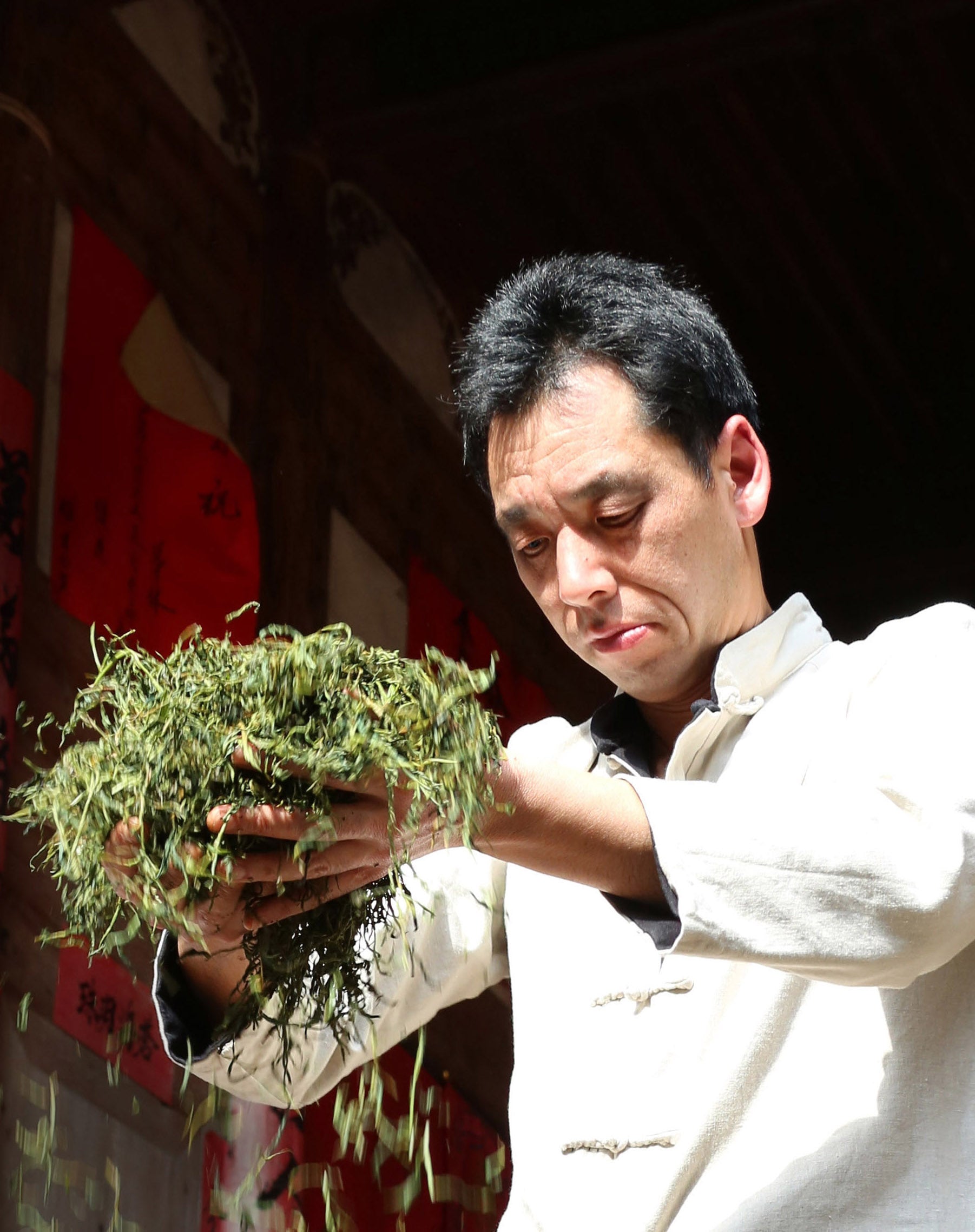
Shi Jikang (1928-2015), the fifth-generation direct descendant of the black tea patriarch.
The masterpiece of Shi Liqiang, the sixth-generation direct descendant and inheritor of intangible cultural heritage.
Aroma Prime Tea, a globally unique black tea variety.
It has been granted the "Plant Variety Right" certificate by the Ministry of Agriculture of the People's Republic of China, with the variety right number CNA20184364.8 and certificate number 2023026927.
CCTV10 Science and Education Channel and several other media outlets reported on this.
Its contribution to tea science in "anti-aging" is described as "the fragrance of Chinese tea that reverses age and preserves youth."
The world's only gene bank for red and purple bud black tea
Numerous academic evidences, including those from the journals *J. Nutr Biochem*, *Food Chem*, and *Science in China*, have provided academic confirmation.
The world's only remaining 2-acre mother tree orchard has 87% purple-red leaves.
Anthocyanin content is more than 50 times that of ordinary tea (certified by the Chinese Academy of Agricultural Sciences in 2015).
Its content of lipid-type catechins is unparalleled in the tea industry, resulting in a breakthrough improvement in antioxidant efficacy.
The Ruby Rose tea liquor carries a cool rose fragrance, and its aftertaste is as velvety as a gentle touch. With an annual production of less than 100 kilograms, the value of this red rose tea extends far beyond the teacup. At the 2017 "Shanshan Night" charity auction at the Peninsula Hotel Shanghai, it was housed in a rosewood box engraved with swastika patterns and sold for 450,000 yuan, its aroma embodying the priceless power of love.
The Tea Souls of Two Generations of the Shi Family:
In 1950, Shi Jikang began his research on red and purple buds.
In 2000, Shi Liqiang completed the variety standardization, marking a milestone in tea history.
[Collection Access Open]
In the past, tea was only available at auctions; now, private customization is available, with each tea leaf undergoing a 600-day natural reddening process.
Year: 2024
Level: Top Rare
Producer: Shi Liqiang, inheritor of the intangible cultural heritage of Gongfu black tea and the creator of this tea variety.
Origin: Tanyang Village, Fujian, China, the birthplace of Tanyang Kung Fu
Variety: Red Rose Crown Fragrance Red Aroma Prime Tea
(Legal protection of plant variety rights: Without the permission of the plant variety rights holder, no entity or individual may produce, propagate, or sell the propagation material of that variety; otherwise, it constitutes an infringement.)
The variety namer and the right holder personally recommend it.
Craftsmanship: Shi family's seven-screening and eleven-step process, Guanxiang's ancient method. Protecting core techniques: "Double smoking" and "three freezing and two sun-drying" control methods.
Dry tea appearance: single bud, The buds are quite plump.
The soup is golden yellow, with an amber color.
Aroma: It has a rich floral fragrance ( with a hint of rose), which is refreshing and pleasant.
Taste: This tea is fragrant in water, with a scent similar to roses. It is smooth and mellow on the palate, with a delicate sensation that unfolds slowly. The taste is tender, fragrant, rich, mellow, and sweet.
Tea liquor color : The tea liquor is golden yellow, with an amber hue.
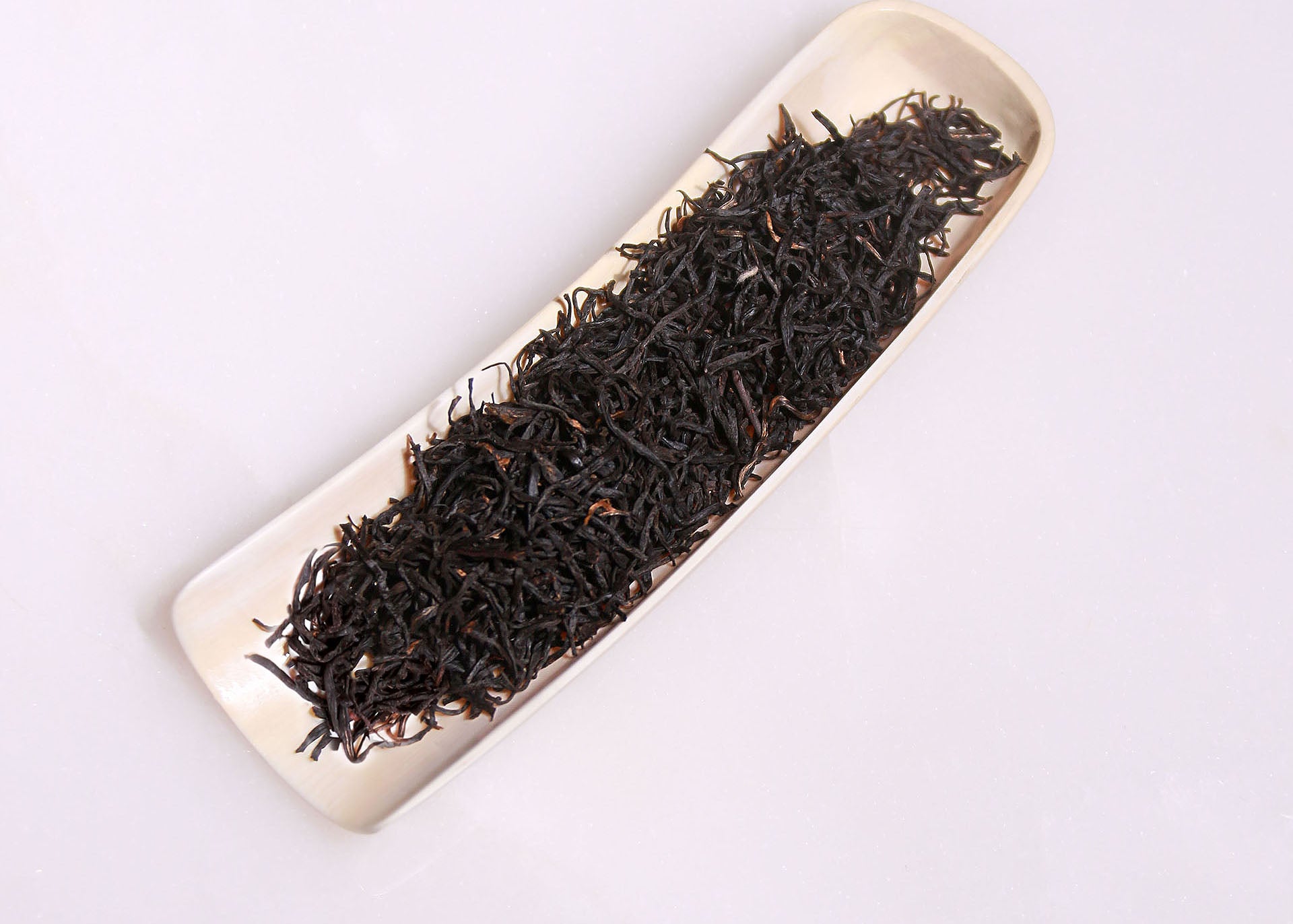
The dry tea leaves are composed of tender buds, with tightly rolled, dark black strips.
Research Outline and Core Summary
Purple is superior, green is secondary.
Lu Yu, the "Sage of Tea" in China , once praised purple bud tea, saying, "Purple is superior, green is inferior." "Guanxiang Black Tea" has 87% purple-red color and a unique aroma, thanks to its high-quality tea tree variety that has undergone a mutation and reddening process.
The "2015 Chinese Agricultural Science Research on the Utilization of Red and Purple Tea Buds" shows that the anthocyanin and lipid-type catechin content of red leaf and red heart tea is 10-50 times higher than that of ordinary tea, and has significant antioxidant and anti-aging effects.
Anti-aging research and human trials of modern red and purple bud tea
Human trials: After drinking purple bud tea daily for 3 weeks, subjects showed a 15% increase in plasma antioxidant capacity (ORAC value).
Research: Liu Z, et al. Purple tea improves antioxidant status in healthy adults. J Nutr Biochem. 2018;58:30-37.
The unique characteristics of purple bud tea: Purple bud tea has a significantly higher anthocyanin content than ordinary tea.
Research: Zhao Y, et al. Anthocyanin composition and antioxidant activity of purple tea. Food Chem. 2020;331:127356.
Telomere protection and cell senescence
Anthocyanins slow down telomere shortening (telomere length is related to cell replication lifespan).
Research: Shay JW, et al. Anthocyanins extend lifespan in Drosophila melanogaster. Aging Cell.
Skin anti-aging
Purple sweet potato and skin elasticity: Purple sweet potato extract can reduce UV-induced collagen degradation.
Research: Tominaga Y, et al. Purple sweet potato anthocyanins attenuate skin photoaging. J Dermatol Sci. 2019;93(1):41-48.
Wrinkle improvement: Clinical trials have shown that consuming purple cabbage extract for 12 consecutive weeks can reduce the depth of facial wrinkles.
Research: Jeon YJ, et al. Effects of purple cabbage extract on skin aging. J Cosmet Dermatol. 2020;19(2):474-481.
Antioxidant mechanism : Anthocyanins reduce oxidative stress by scavenging free radicals (ROS) and activating endogenous antioxidant systems (such as the Nrf2 pathway).
Research : Wallace TC, et al. Anthocyanins in Cardiovascular Disease . Adv Nutr. 2011;2(1):1-7.
Long-term consumption of purple vegetables can lower blood pressure, blood sugar, and blood lipids (indirectly delaying organ aging).
Research: Wu X, et al. Purple vegetable consumption and metabolic health. Nutrients. 2017;9(2):128.
Shi Jikang began research on Guanxiang black tea in 1950, and Shi Liqiang began variety finalization in 2000. Anthocyanins belong to the flavonoid polyphenolic compounds, which can inhibit lipid peroxidation, scavenge free radicals, and have antioxidant, anti-aging, weight loss, and anti-radiation effects.
Guanxiang black tea, made from red and purple buds, is a crystallization of nature's gifts and craftsmanship.
We thank Shi Jikang and Shi Liqiang, two generations of the Shi family, for contributing unique black tea varieties and exquisite techniques to the world.
When century-old archives awaken
Deciphering the Taste Code Across Time and Space in the Third Century
Fengtailong's classic Gongfu black tea process involves "seven sieving and eleven steps, using the Guanxiang Ancient Method." The aroma of Fengtailong tea served at Queen Victoria's Windsor Castle state banquet in 1887 originated from this process. Compared to ordinary Gongfu black tea, the Guanxiang Ancient Method involves more secret techniques and several more sieving and refining processes, making it a classic example of refined Gongfu tea.
What is the meaning of "gongfu" in Gongfu black tea?
"Gongfu black tea" gets its name from its complex, technically demanding, and time-consuming production process.
"Guanxiang Black Tea" is sieved through seven stages, making it a top-grade fine Gongfu tea. Shi Liqiang, in order to revive his family's "Guanxiang" tradition, continuously cultivates and optimizes the Guanxiang black tea variety and refines traditional tea-making techniques, thus both preserving and promoting the development of Tanyang Gongfu black tea.
As the origin of Gongfu black tea, Fengtailong's "Guanxiang Black Tea" is not the end of the process, but the prelude to the inheritance.

Dayatang Red Rose (Guanxianghong) Black Tea has been awarded the "Plant Variety Rights" certificate by the state and has been reported by CCTV10 and other media outlets.
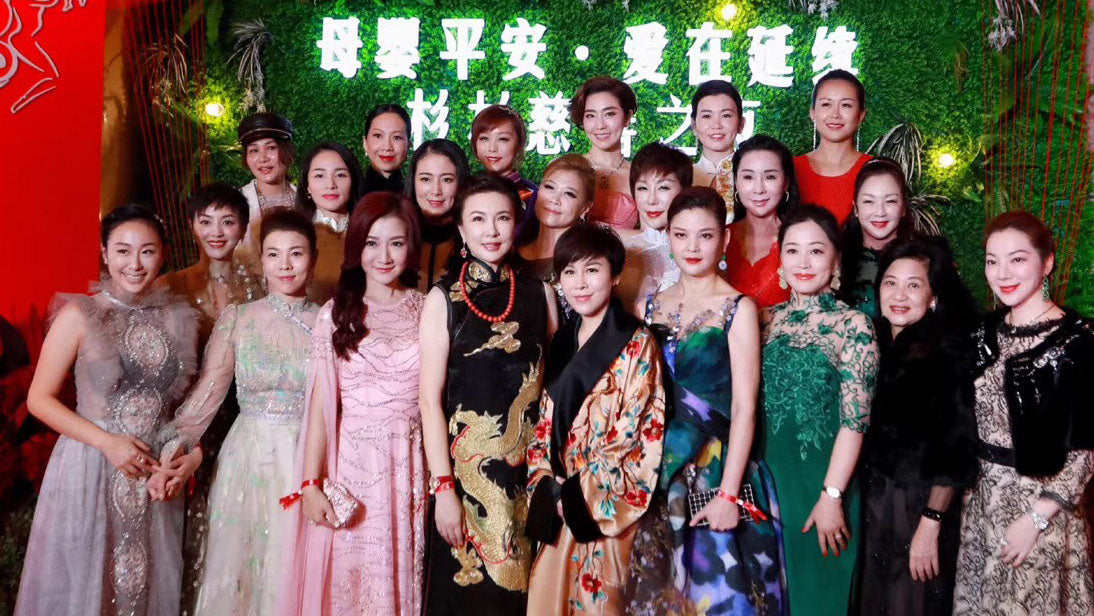
On November 30, 2017, the "Red Rose" charity auction at The Peninsula Shanghai was held at the Grand Elegance Hall, supporting charitable causes.
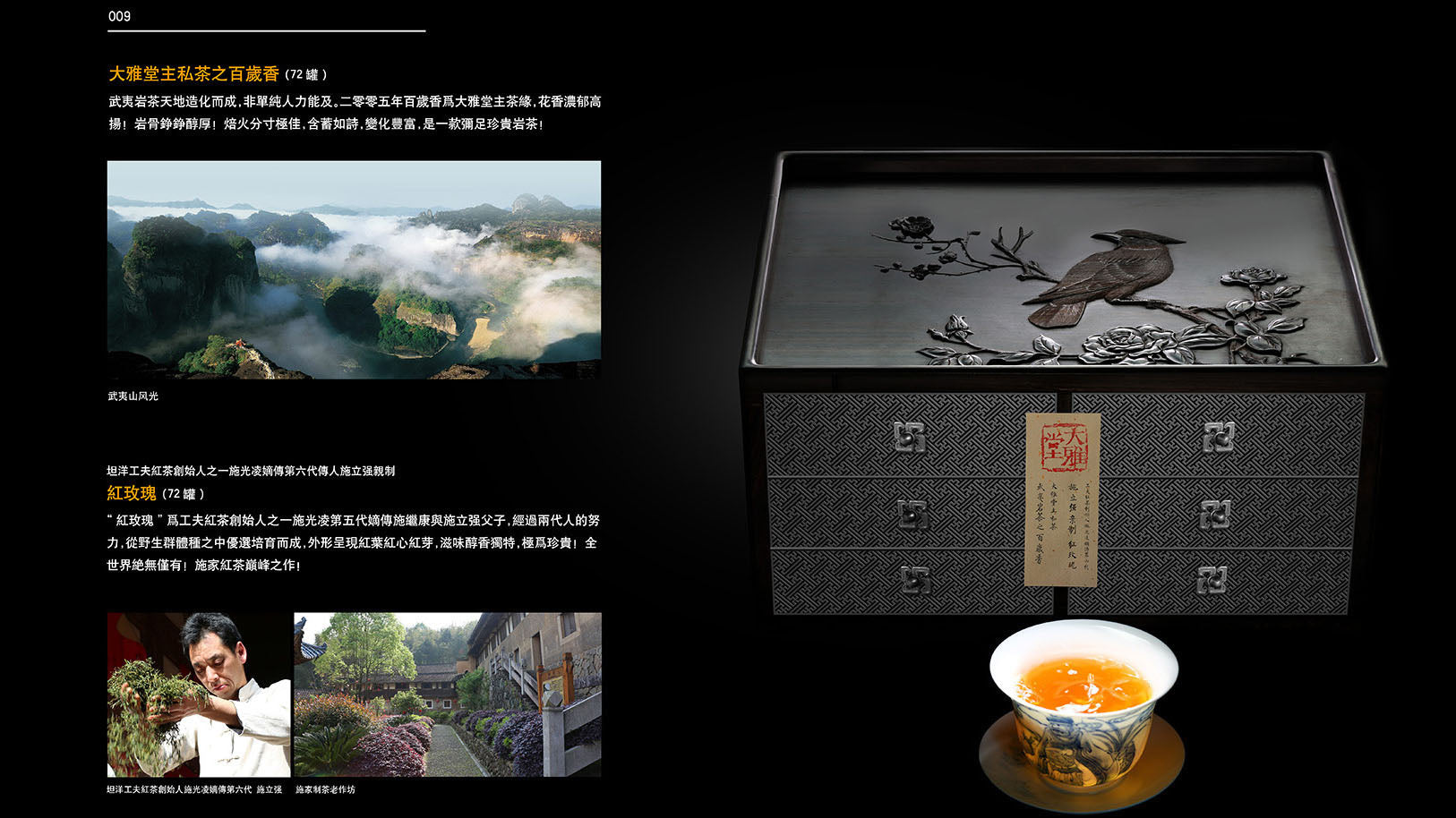
On November 30, 2017, the "Red Rose" and "Centenarian Fragrance" from Daya Hall were featured in the "Shanshan Night" charity auction at the Peninsula Hotel Shanghai. (Original image of the auction items)
DayaTang owns two major brands: "F.T.L. 豐泰隆"
and "DayaTang 大雅堂" (registered trademarks)
A Cup of Good Tea
the Perseverance and Heritage of Six Generations
DayaTang owns two major brands: "F.T.L. 豐泰隆"
and "DayaTang 大雅堂" (registered trademarks)

F.T.L.:Since 1851
F.T.L. 豐泰隆 is the brand with the most complete and clearest-traceable lineage in the inheritance system of the "Tanyang Congou Tea-Making Craft".
As recorded in Memorial to the Throne by Yinggui, Viceroy of Fujian and Zhejiang: "The single village of Tanyang produces over 7,000 crates of tea annually, accounting for more than 70% of Fujian black tea output".

(1827.9.9 – 1893.4.4)
Shi Guangling was the founder of F.T.L. 丰泰隆.
He was also one of the founders of Tanyang Congou black tea and a pioneer of China's modern tea industry.
He pioneered the maritime tea route for Fujian black tea.
He invented the double-smoking method, and due to the excellent quality of its tea, F.T.L. 丰泰隆 was selected as a supplier of specialty tea for the British royal family.

Cross-verification: Annotated Original Text of the 1888 Entry in the "Royal Specialty Procurement Records"

1889, LS 4/132, Held in the National Archives of the UK
Accounting records of the Lord Steward’s Office (Royal Household) show:
"The expenditure on purchasing F.T.L. 豐泰隆 double-smoked black tea accounted for 17% of the budget for Eastern teas,
(1895-1972)
Shi Zuofan (style name: Fulong), the great-grandson of Shi Guangling, was one of the founders of China's tea industry in the new era and the first Chief Tea Evaluator of the State-run Fu'an Tea Refining Factory.
He systematically established the modern black tea evaluation system, trained the first batch of tea experts aiding foreign countries, and his compiled work Essentials of Minhong Black Tea Refining remains a classic textbook in tea science.
Core Contribution: Formulated industry standards for China's black tea industry;Technological Innovation & Inheritance: "Step-by-Step Fermentation Method";During the special period, he protected traditional tea-making techniques.
In 2021, the Tanyang Congou Intangible Cultural Heritage Protection Center recognized him as the "Founder of the Modern Black Tea Refining System".
The tea-making workshop of F.T.L. 豐泰隆 holds significant importance in the history of tea production and is recognized as a cultural relic in China.

(1928-2015)
Shi Jikang: Tea Scientist, Tea Engineer, and Head of the Technology Section of the State-run Tanyang Tea Factory.
During the special period, he was sent to the countryside for labor reform due to his landlord family background. At that time, the tea-making technique of Chinese Congou black tea was on the verge of being lost, and Shi Jikang protected this intangible cultural heritage (ICH) with his life:
In the winter of 1969, Shi Jikang used an ox-cart to hide six crates of old tea-making tools engraved with "F.T.L. 豐泰隆" in an abandoned kiln on the north slope of Baiyun Mountain;
In 1972 (recorded in the 2005 edition of Tanyang Village Chronicles), Shi Jikang transferred a batch of old tea-making tools to the home of his relatives in Xiapu County;

Shi Liqiang is a representative inheritor of the traditional tea-making technique of Tanyang Congou black tea and a tea industry innovator in the 21st century.
The intangible cultural heritage (ICH) collection tea products supervised by Shi Liqiang set a record for contemporary black tea auctions at 450,000 yuan per box in the charity auction held by the Song Qingling Foundation. CCTV programs such as Science and Education Channel and Exploring and Discovering have produced featured reports on him and his related deeds.
AromaPrimeTea 冠香红 & Double-Smoking Method – The Oriental Taste Code Flowing in the Genes
Six generations have guarded the inheritance of taste through the double-smoking technique (with 0.8% theaflavin) and AromaPrimeTea 冠香红 (with an 85% purple bud rate).
The royal tribute tea (recorded in the 1887 Golden Jubilee Tea List) and global evidence (the 1908 tea crate in Singapore) confirm its 174-year cultural depth. From the auction premium in London to the contemporary transaction price of 450,000 yuan per box, it continues to write the charm of Oriental tea through traditional charcoal roasting and genetic innovation.

Brand Epic

Incense Offering at Zhenwu Bridge - A Tale of the Tea Town

Daughter Learning to Make Tea - A Tale of the Tea Town
Craftsmanship never fades
Moving from yesterday to the future
Time carves traces on the tea caddy
F.T.L. 豐泰隆's tea aroma penetrates 174 years of time
Vicissitudes continue
the cultural context
Each gram of tea carries a family's 174 years of day-and-night guardianship
Through six generations of tea masters' perseverance
Complex brewing
exacting attention to details
Only to help you taste the true flavor
of tea aroma
Each gram of tea carries a family's 174 years of day-and-night guardianship
Through six generations of tea masters' perseverance
Complex brewing, exacting attention to details
Only to help you taste the true flavor of tea aroma
Brew
1. Prepare tea warmer
Gaiwan (lidded bowl), Yixing teapot, and glass teaware are all suitable.
Warm the cup with boiling water before brewing.
II. Adding tea leaves and shaking to release aroma
We recommend using 3-5 grams of tea leaves, but you can adjust the amount according to your personal taste. After adding the tea leaves, gently shake the container to release the aroma.
III. Brewing and Drinking
Let the boiling water cool to about 80 degrees Celsius. It is recommended to use a gentle, slow, steady pouring method, pouring water slowly over the tea leaves to allow them to be evenly moistened and unfurl, thus promoting a balanced flavor and aroma in the tea.
The first two infusions should be poured out within 2 seconds, the third within 3 seconds, and subsequent infusions can be poured out within a certain time. The aroma will linger after 7 infusions.
Brewing tips:
First: Always brew at a low temperature . If you use boiling water (100 degrees Celsius) for the first infusion, the tea will easily become strong and bitter. After the mouth is stimulated, even if subsequent water temperatures are suitable, the tea will taste weak. This is due to the characteristics of oral sensation. Therefore, using boiling water for the first infusion will cause the tea to lose its original wonderful experience.
This principle applies to all high-grade Chinese teas made from "tender buds," such as Mengding Ganlu and Biluochun. Generally speaking, the more delicate the buds, the lower the water temperature should be; the larger the leaves, the higher the water temperature can be.
Second: A single brew of tea should be completed within 20 minutes . If it cannot be finished immediately, store it in a container. When you wish to drink it again, reheat the previously brewed tea, and instantly the room will be filled with its fragrance, which will be intoxicating.
Do not leave steeped tea in the gaiwan for an extended period (such as one or two hours) before re-steeping. This is because oxidation occurs, deepening the oxidation of tea polyphenols, weakening the original fresh and crisp flavor, and causing aromatic substances to evaporate, resulting in a bland taste. Such brewing transforms a fine tea with rare qualities into a lackluster drinking experience.
This tip applies to all Chinese teas with exceptional aroma and flavor, especially those with a "highly aromatic" character.
The exceptions are aged Chinese teas and those with a heavily roasted and fermented style, which can be steeped slowly, brewed slowly, or boiled slowly.
For brewing instructions on aged black tea, please refer to "A Guide to Slow-Brewing Aged Black Tea".
一般泡 “香茶” 用软水,泡 “老茶” 用硬水。

Please refer to the traditional Chinese black tea brewing method.

Tanyang Village, China – the origin of world-class black tea
The charm of tea ceremony lies
in what suits you as precious
A pot of pure water is enough
Don't be trapped by water quality metaphysics
A pot of pure water is enough
Don't be trapped by water quality metaphysics
The charm of tea ceremony lies
in what suits you as precious
Package
"Forged Through Thousands of Hammers" Handcrafted Pure Tin Can
Height: 15 cm | Diameter: 11 cm | Net Weight: 250 g
Crafted by Sheng Yiyuan, ICH Inheritor of Yongkang Tin Carving.
The can body is shaped through thousands of manual hammer strikes, boasting a delicate and warm texture. Each hammer mark—varying in depth—stands as a unique imprint, a vivid testament to the warmth of handcraftsmanship and the profound meaning of intangible cultural heritage ingenuity.
The interior is finely polished using precision numerical control (NC) technology, ensuring a smooth and burr-free surface. The lid and mouth, crafted with high-precision techniques, achieve an airtight seal. This fusion of handcrafted warmth and modern technical precision preserves ancient charm while guaranteeing practicality.

Height: 15cm, Diameter: 11cm, Net weight of tea: 240g

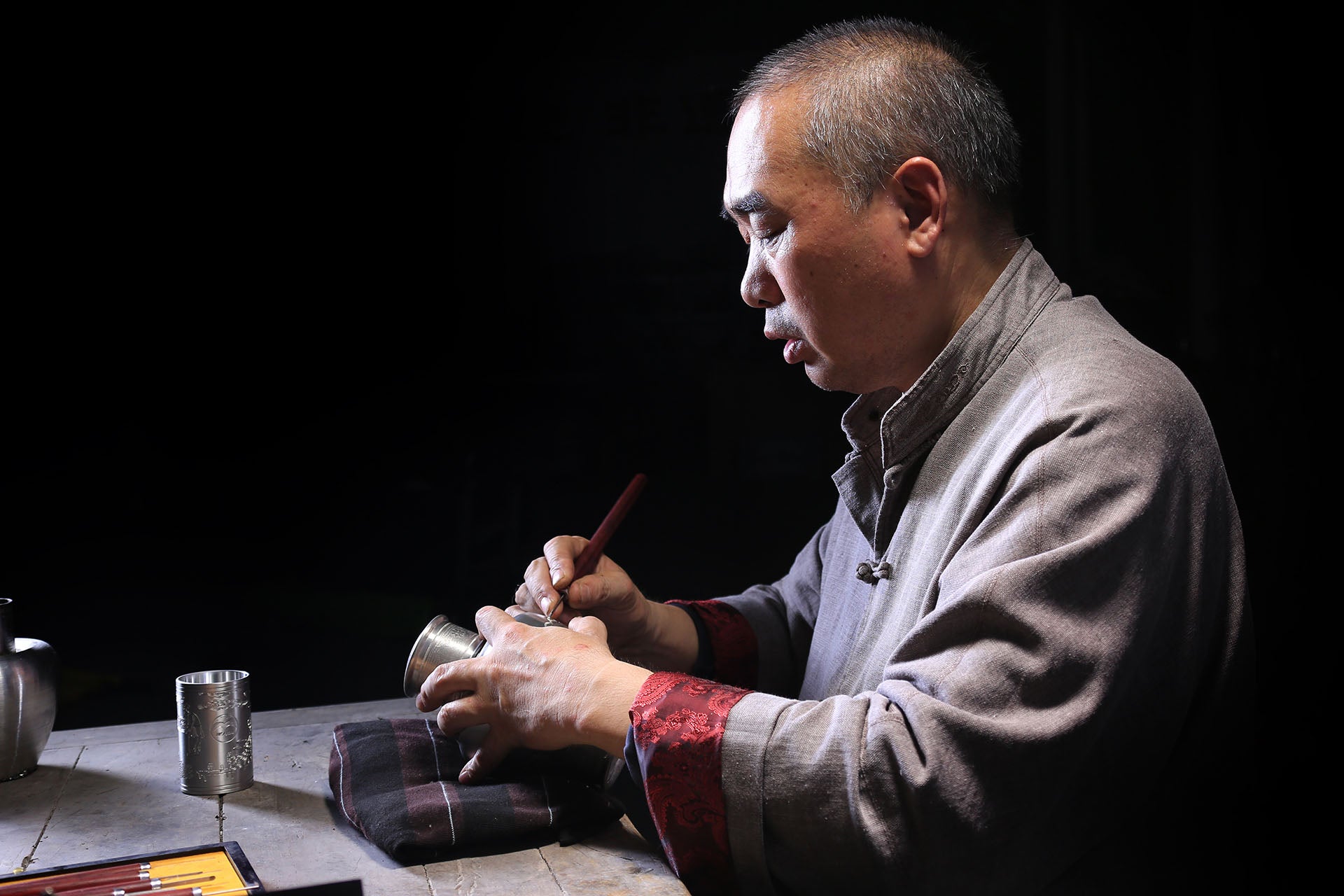
Sheng Yiyuan,ICH Inheritor of Yongkang Tin Carving
storage

Store in a sealed container in a clean, odorless, and dry environment.
The ideal temperature is below 25 degrees Celsius. Avoid direct sunlight and moisture.
Note: Avoid opening the container frequently.
Every time the container is opened, the tea leaves come into contact with air and moisture, which accelerates the oxidation and deterioration of the tea.
Therefore, minimize the number of times you open the storage container.
Shelf life
Long-term storage is possible if the above storage conditions are met.
1-year appreciation period
Aroma: Compared to aged tea, the aroma is fresher, more invigorating, and more pronounced, with a noticeable floral and sweet fragrance, and a high degree of freshness.
Taste: Fresher and more vibrant than aged tea. Upon tasting, the robust inner qualities of the tea leaves are clearly perceptible, with a full-bodied flavor and a rapid and pronounced aftertaste.
Enjoy after 5 years or more of storage
Aroma: The floral and fruity aromas gradually fade, transforming into a rich and deep aged aroma, woody aroma, and camphor aroma, accompanied by a slight medicinal aroma.
Taste: The taste becomes increasingly mellow and smooth. After years of storage, the chemical composition of the tea leaves changes, and the content of irritating substances such as tea polyphenols decreases, resulting in a milder taste, a rich and mellow liquor, a long-lasting aftertaste, and a smooth and delicate flavor with a unique character.






